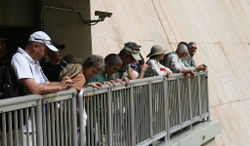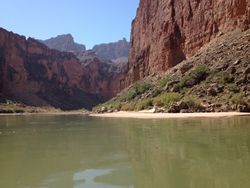Main Page
The Secretary of the Interior Bruce Babbitt, created the GCDAMP in response to the 1995 Environmental Impact Statement on the Operations of Glen Canyon Dam. The GCDAMP is responsible for implementation of the Grand Canyon Protection Act of 1992, to monitor the operation of Glen Canyon Dam, to ensure the dam is operated in compliance with a range of laws and regulations and mitigate any significant environmental impacts. This program is considered to be one of the most successful examples of adaptive management in the country.
The GCDAMP is comprised of a variety of stakeholders with disparate interests in the resource. They range from federal and state agencies, Native American Indian Tribes, the Colorado River Basin States, electrical utility consortia, recreational groups, and environmental groups. The AMWG strives for balance and consensus on how to protect downstream resources and in their recommendations to the Secretary on the operation of the Dam.
TWG is comprised of technical representatives from each group represented by AMWG and performs tasks assigned by that group. Tasks include, developing criteria and standards for monitoring and research programs, providing periodic reviews and updates, developing resource management questions for the design of monitoring and research by the GCMRC and providing information for preparing annual resource reports and other reports for the AMWG. GCMRC is dedicated to providing credible, objective scientific information to the GCDAMP through the TWG on the effects of operating Glen Canyon Dam and other management actions on the downstream resources of the Colorado River ecosystem.

Just a little shout out for Jason... who got this whole Wiki thing started.
|
|
|
|
![]() SEDIMENT |
SEDIMENT |
![]() FISH |
FISH |
![]() HYDROPOWER |
HYDROPOWER |
![]() CULTURAL |
35pxSOCIOECONOMICS |
CULTURAL |
35pxSOCIOECONOMICS |
![]() FOOD BASE |
FOOD BASE |
![]() TEMPERATURE |
35pxWATER QUALITY |
TEMPERATURE |
35pxWATER QUALITY |
![]() RECREATION |
RECREATION |
![]() ECOSYSTEM |
ECOSYSTEM |
![]() FISHERY |
FISHERY |
![]() EXTIRPATED |
EXTIRPATED |
![]() Science Advisors |
Science Advisors |
![]() GCDAMP Glen Canyon Dam |
GCDAMP Glen Canyon Dam |
![]() Hydrology |
Hydrology |
![]() Tribal Ecological Knowledge |
Tribal Ecological Knowledge |
![]() Knowledge Assessment|
Knowledge Assessment|
![]() Resource Stats |
Resource Stats |
![]() Acronyms--Terms
Acronyms--Terms



